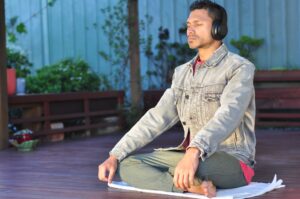Introduction
Social anxiety often makes eye contact a challenging feat, especially for introverts who might already feel overwhelmed in social settings. However, there’s a bright side. With the right strategies, anyone, including introverts, can master the art of maintaining eye contact, leading to more comfortable and meaningful conversations. This article dives deep into practical and effective methods to ease the tension around eye contact. It also touches upon an unconventional process: the introvert to extrovert transition. With a positive outlook and a willingness to embrace change, mastering eye contact can become a rewarding journey towards improved social interactions. So, let’s get started! 👀✨

Understanding Social Anxiety and Eye Contact
For many introverts grappling with social anxiety, the act of maintaining eye contact can feel daunting. It’s as if the simple, seemingly mundane task of looking someone in the eyes carries a weight heavy enough to skew an entire interaction. But why is this the case? Social anxiety is often rooted in a fear of judgment or negative evaluation from others, leading individuals to become overly self-conscious and anxious in social situations. Eye contact, a fundamental component of face-to-face communication, becomes a focal point of this anxiety.
Eye contact is more than just a visual exchange; it’s a non-verbal form of communication that conveys confidence, interest, and attentiveness. However, for someone with social anxiety, this exchange can trigger a flood of self-doubt and worry. Thoughts like, “Am I making too much eye contact?”, “What if they think I’m being rude or overly intense?”, or “I must look so awkward right now” can dominate the mind, turning a simple conversation into an internal battle.
But understanding this anxiety is the first step toward overcoming it. By recognizing the patterns of anxious thoughts and the physical responses that accompany them, individuals can begin to demystify the process and challenge their fears. This means approaching eye contact not as a threat, but as a skill to be developed and refined over time.
To aid in this journey, we’ve created an advanced introvert test that can help pinpoint specific areas of social interaction that may need attention. By understanding one’s own tendencies and reactions, the path towards mastering eye contact and reducing social anxiety becomes clearer. This test serves as a guide, providing insight and strategies tailored to each individual’s experience, making the process of change not just possible, but achievable.
Remember, change doesn’t happen overnight, but with persistence and the right tools, progress is within reach.

The Impact of Avoiding Eye Contact
Avoiding eye contact might seem like a viable solution for those grappling with social anxiety, but this avoidance can have significant repercussions. When individuals shy away from making eye contact, it sends a cascade of non-verbal cues to the other person, potentially leading to misunderstandings and a lack of connection. People may perceive this avoidance as disinterest, lack of confidence, or even unfriendliness, which is often far from the truth.
For introverts striving to navigate social interactions more smoothly, understanding this impact is crucial. Avoiding eye contact not only hinders clear communication but also reinforces the anxiety surrounding social interactions. It becomes a cycle: the more one avoids eye contact, the more daunting it seems, and the anxiety continues to build.
By facing this challenge head-on, individuals can start to break the cycle and reshape their social experiences. This does not mean forcing oneself into uncomfortable situations unprepared. Instead, it involves gradual exposure and practice, coupled with supportive strategies to manage the anxiety. Our intro to extro community is a great place to start this journey, offering a platform to discuss these challenges and learn from others who have walked a similar path.
Engaging with a community provides a sense of belonging and understanding, which is invaluable for anyone looking to overcome social anxiety. It’s a space where sharing experiences and strategies becomes a source of strength and empowerment, helping to diminish the impact of avoiding eye contact and paving the way for more positive social interactions.
In this supportive environment, introverts can thrive, transforming their approach to eye contact from a source of anxiety to a tool for connection, one interaction at a time.

Benefits of Improving Eye Contact
Mastering the art of eye contact can unlock a world of positive change, particularly for introverts navigating the complexities of social anxiety. It’s more than just a way to make conversations less awkward—it’s a gateway to building stronger, more genuine connections with others. By maintaining eye contact, individuals communicate confidence, attentiveness, and interest, creating a foundation for meaningful interactions.
When eye contact is consistent and appropriate, it helps in establishing trust. People tend to view those who maintain good eye contact as reliable, sincere, and capable. For introverts, this can be particularly empowering, as it provides a non-verbal means of expressing oneself and establishing presence in social settings. It also aids in better understanding and interpreting others’ emotions and reactions, leading to more empathetic and responsive interactions.
As confidence in making eye contact grows, so does the ability to manage and reduce feelings of anxiety in social situations. This self-assurance doesn’t just apply to conversations—it extends to other areas of life, influencing how individuals perceive themselves and their capabilities.
To support this journey of improvement, we have crafted a unique intro to extro roadmap. This guide stands apart from conventional advice, offering tailored strategies and insights to help introverts navigate their way toward better eye contact and reduced social anxiety. It’s a resource that acknowledges the challenges, yet provides practical and achievable steps toward change.
Embracing the benefits of improved eye contact is about recognizing its power to transform social interactions and personal confidence. For introverts ready to take this step, the rewards are well worth the effort, leading to richer, more rewarding connections with others and a renewed sense of self-assurance in social settings.

Eye Contact and Cultural Differences
Navigating the nuances of eye contact becomes even more complex when cultural differences come into play. Around the world, eye contact holds various meanings and implications, making it a crucial aspect to consider for anyone aiming to improve their social interactions. For introverts, particularly those dealing with social anxiety, understanding these cultural subtleties is key to effective communication and relationship-building.
In some cultures, direct eye contact is seen as a sign of confidence, honesty, and interest. It’s a positive and expected part of engaging with others. In others, however, it may be perceived as rude, confrontational, or inappropriate, particularly when occurring between individuals of different social statuses or genders. The balance between maintaining eye contact and avoiding it becomes a delicate dance, requiring awareness and sensitivity to cultural norms.
Introverts, with their often keen observational skills, can turn this challenge into an opportunity. By paying attention to social cues and being mindful of cultural contexts, they can navigate eye contact in a way that respects different values and expectations. This awareness not only aids in reducing social anxiety but also enhances cross-cultural communication skills, opening doors to more diverse and enriching interactions.
To support this learning process, seeking out resources, and engaging with diverse communities can provide invaluable insight. It’s about embracing the diversity of social interactions and using it as a tool for personal and social growth.
By acknowledging and adapting to the varied meanings of eye contact across cultures, introverts can navigate social interactions with greater ease and confidence. They transform a potential source of anxiety into a pathway for connecting with others on a deeper, more meaningful level, regardless of cultural backgrounds.
Overcoming Setbacks: Staying Resilient
Embarking on the journey to improve eye contact and mitigate social anxiety is commendable, but it’s important to acknowledge that setbacks are a natural part of the process. Even the most committed individuals may face moments of doubt or find certain situations overwhelming. For introverts, these moments can feel particularly challenging, yet they also offer valuable opportunities for growth and resilience building.
When setbacks occur, it’s crucial to maintain a positive and forgiving mindset. Understand that progress is rarely linear, and occasional hurdles do not equate to failure. Reflecting on these moments, rather than dwelling on them, can provide insight into specific triggers or situations that require additional attention and practice.
One effective strategy for staying resilient is to set realistic and achievable goals for improving eye contact. Break the broader goal into smaller, manageable tasks, celebrating progress along the way. This approach not only keeps motivation high but also provides a clear path forward, even when challenges arise.
Additionally, developing a support network of friends, family, or like-minded individuals can provide encouragement and understanding. Sharing experiences and strategies with others who are on a similar journey fosters a sense of community and belonging, essential components for resilience.
Another crucial aspect of overcoming setbacks is self-care. Ensuring adequate rest, engaging in activities that bring joy, and practicing stress-reduction techniques can all contribute to a stronger emotional foundation, better equipping individuals to handle moments of anxiety or uncertainty.
By embracing setbacks as learning opportunities, maintaining a positive outlook, and cultivating a supportive environment, introverts can continue to progress on their journey to improved eye contact and reduced social anxiety. Resilience becomes not just a tool for overcoming challenges but a testament to their commitment to personal growth and better social interactions.
Real-Life Success Stories
Hearing about the journeys of others who have successfully navigated the challenges of social anxiety and eye contact can be incredibly inspiring and motivating. Across the globe, introverts have embarked on this path, finding ways to turn their struggles into strengths and share their stories to uplift others.
One compelling example is Emma, a software developer who once found team meetings and presentations unbearable due to her intense fear of eye contact. Recognizing the impact this was having on her professional growth, Emma decided to take action. She started small, practicing eye contact with family members and gradually moving to friends and colleagues. Over time, and with consistent effort, Emma transformed her ability to maintain eye contact, leading to improved relationships at work and a significant boost in her self-confidence.
Then there’s Raj, a college student who always felt isolated due to his social anxiety. Realizing the importance of connections and networking in his future career, he made a conscious effort to work on his eye contact and social skills. Joining various student organizations and participating in public speaking workshops, Raj challenged himself to step out of his comfort zone, resulting in a newfound ease in social interactions.
Stories like Emma’s and Raj’s are not just inspirational; they serve as tangible proof that change is possible, even for those who have struggled with social anxiety for years. They highlight the power of perseverance, the importance of setting achievable goals, and the transformative impact that improved eye contact can have on an individual’s personal and professional life.
By sharing their journeys, these individuals offer hope and guidance to others on a similar path, proving that with determination and the right strategies, overcoming social anxiety and mastering eye contact is within reach for every introvert willing to embrace the challenge.
Conclusion
In conclusion, mastering the art of eye contact is a powerful step towards conquering social anxiety and building stronger, more meaningful connections in every area of life. For introverts, this journey may present unique challenges, but it also offers unparalleled opportunities for personal growth and empowerment. By understanding the impact of social anxiety on eye contact, embracing the benefits of improvement, and navigating the nuances of cultural differences, individuals can transform their interactions and their perception of themselves. Overcoming setbacks with resilience and drawing inspiration from real-life success stories further solidifies the attainability of this goal. The journey may be gradual, and setbacks are part of the process, but the rewards—enhanced confidence, deeper connections, and a greater sense of personal capability—are well worth the effort. So, take that first step, embrace the challenge, and discover the transformative power of eye contact in overcoming social anxiety and unlocking a world of positive social interactions.




